A grab bag of discoveries was shared online during astronomy confab
This January, the American Astronomical Society held its big annual meeting completely online. The Covid-19 pandemic ruled out the society’s planned gathering in Scottsdale, AZ but the AAS pivoted by opening-up digital access to thousands of astronomers across the United States and around the world. More than 3,000 registrants were listed in the online portal, thus demonstrating that the vital communication of astronomical research, education, and public outreach could carry on in this alternative format. Building on their pilot online meeting in June, the AAS provided new ways for people to “gather” and so build community. I found the Graduate School Fair especially compelling, as I was able to interact with familiar faculty at my alma mater as they conversed with prospective graduate students.

The astronomy meeting’s online portal was designed and animated to resemble the lobby of a convention center during an actual in-person astronomy conference.
Bumps in the Night – Multi-messenger Astronomy Comes of Age:
Astronomy has not been the same since September 14, 2015, when the twin LIGO gravitational- wave observatories first detected a gravitational-wave “chirp” from the violent merger of two stellar black holes. This pioneering discovery was topped on August 17, 2017, when the U.S. LIGO duo and the newly-commissioned European Virgo observatory simultaneously detected the merger of two neutron stars. Here, the improved localization on the sky enabled ground-based astronomers to catch the optical afterglow from the ensuing “kilonova.” These sorts of cosmic collisions involving neutron stars are endowed with a surfeit of neutrons that can glom onto any atomic nuclei in the blast. For this reason, astronomers now think that merging neutron stars are responsible for having manufactured the most massive nuclei – accounting for the heaviest half of the 92 elements that we know about. The silver at your table and the gold adorning your fingers likely came from such violent bumps in the night. Since these two epochal discoveries, gravitational-wave astronomy has rapidly become a force to be reckoned with. Already, more than 50 gravitational-wave events have been recorded, with about one event occurring every six days over the past year. The resulting characterization of masses for the remnant black holes and neutron stars has prompted astronomers to carry out preliminary statistics on the parent populations in the so-called stellar graveyard. What they have found are two segregated families of progenitor masses, contrary to expectations.
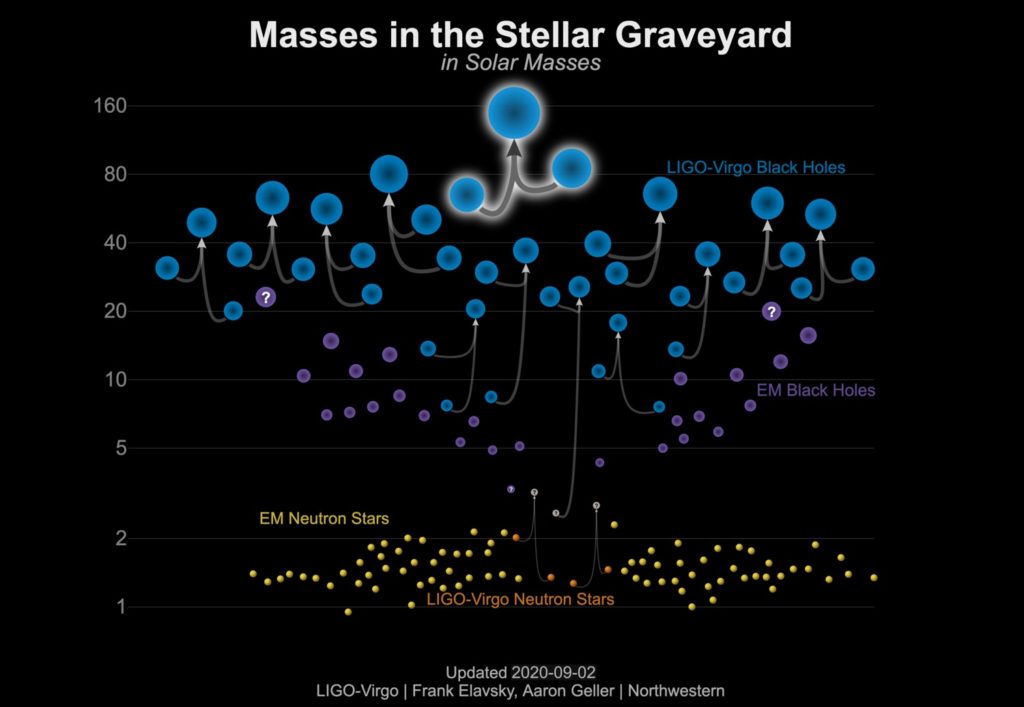
Merging black holes and neutron stars ranked according to their respective and merged masses. The mergers detected via their gravitational waves are indicated in blue (black holes) and orange (neutron stars). The rest were detected via their electromagnetic (light) emission. The apparent desert between the neutron stars and more massive black holes remains unexplained.
The excitement of these and other time-sensitive discoveries has prompted astronomers to build and deploy new rapid-response capabilities with ever-increasing urgency. The National Optical and Infrared Lab (NOIRLab) with funding from the NSF has built and will soon commission the Vera C. Rubin Observatory just for these purposes. Equipped with an 8.4-meter (27-ft) wide mirror and a 3,200 megapixel array of imaging detectors that can capture 10 square degrees of the sky at a wack, the Rubin Observatory will continuously scan the sky in search of novae, supernovae, kilonovae, flaring magnetars, active galactic nuclei, and other celestial outbursts. The resulting generation of data will exceed anything prior by a factor of ten, thus demanding new ways of classifying and flagging objects of interest on the fly. Meanwhile, entire networks of telescopes have been established around the world, so that no outburst gets missed. The Las Cumbres Observatory and its Astronomical Event Observatory Network (AEON) already hosts 25 robotic telescopes with apertures of up to 2-meters wide, ready to be directed towards anything of interest. Indeed, the era of multi-messenger astronomy has only just begun to take off.
Nebular Nurseries – Seen as Never Before:
Understanding the causes and consequences of star formation continues to attract the attention of many astronomers. Several presenters at the meeting shared amazing results on the star-forming process as revealed by the latest and most advanced instruments. The Stratospheric Observatory for Infrared Astronomy (SOFIA), in particular, showed just what it could do to advance the field. SOFIA is a 747S jet aircraft, outfitted with a 2.7-meter wide telescope, that flies above more than 99 percent of the Earth’s atmosphere. This capability enables astronomers to map out the far-infrared emission from cosmic objects – a type of electromagnetic radiation (light) that cannot be detected from the ground. Multiple presentations by SOFIA scientists focused on the nebular architecture and dynamics of star-forming regions.
Using the far-infrared upGREAT spectral imager on SOFIA, they have been able to dissect the nebular consequences of intense star formation. Their view of the Orion nebula, together with the Green Bank Observatory’s radio view of the underlying molecular cloud, have completely upended our understanding of this most prototypical starburst region. No longer are we witness to your grandmother’s Orion nebula. Instead, the new observations have revealed an expanding bubble of warm ionized gas that has been windblown by hot stars recently spawned from a sinuous filament of dense cryogenic molecular gas.

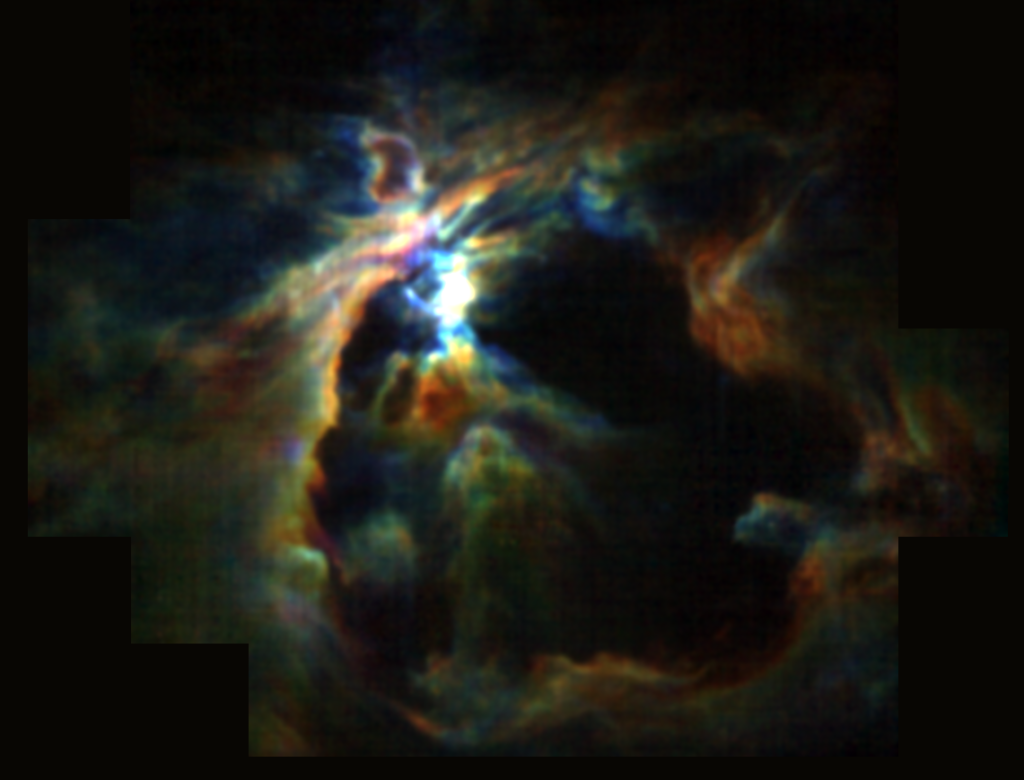
New views of the Orion star-forming region reveal: (Top) A narrow filament of cold and dense molecular gas (observed by the Green Bank Observatory in the radio 1.27 cm emission line of ammonia) along with a diffuse shell of star-warmed dust (observed by the WISE satellite in the far-infrared). (Bottom) Winds from the molecular cloud’s hottest newborn stars have inflated an expanding bubble of warm ionized gas (observed by SOFIA in the far-infrared 158 micron emission line of ionized carbon). The winds are thought to dominate over all other energetics in this nebula.
Using the photopolarimeter HAWC+ on SOFIA, astronomers also have created evocative images of the magnetic fields that course through and govern the nebular flows in the stellar nurseries. Beginning with the Orion’s dense molecular filament, the magnetic fields are seen to be oriented perpendicular to the molecular spine. This orientation is consistent with the notion that the filament was formed as molecular gas gravitationally condensed parallel to the magnetic fields – where the magnetic resistance would be minimal. Indications of a “wasp waist” in the magnetic field orientations suggest a fascinating interplay between the gravitational and magnetic dynamics. Similar interplays are in evidence with the starbursting Cigar Galaxy (M82), where the bevy of newborn hot stars and their combined outflows have taken the magnetic fields for a brisk ride. Lastly, the magnetic fields in our Milky Way’s central mini-spiral and in the entire disk of the spiral galaxy M77 appear to play seminal roles in structuring these diverse systems.
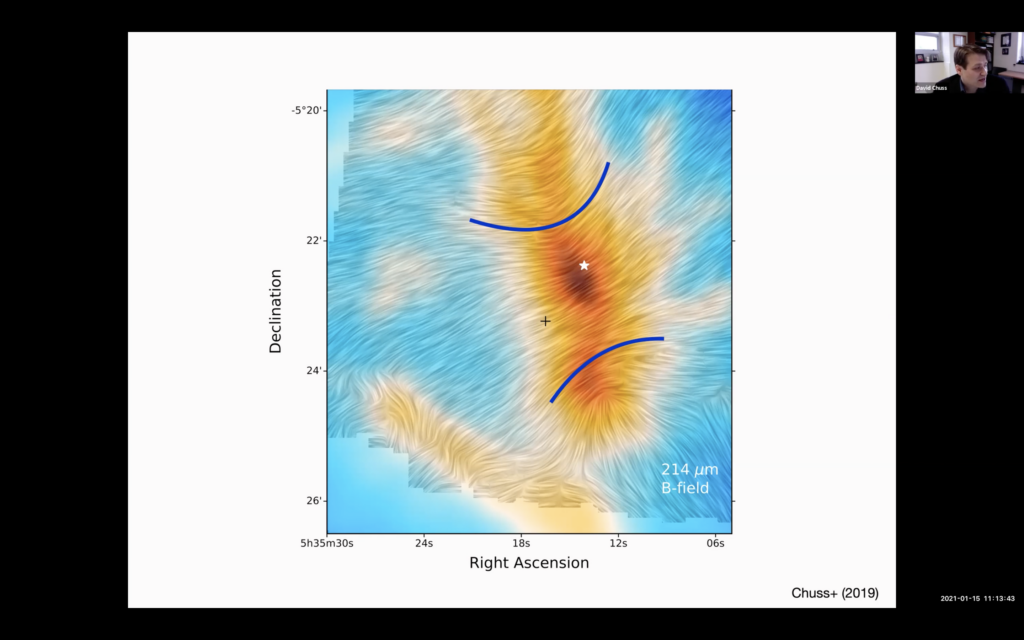

Magnetic fields revealed by SOFIA’s HAWC+ photopolarimeter are seen to direct the inflow of gas and dust onto Orion’s molecular filament (top) – and, in turn, to be directed by the outflow of hot gas from the starbursting “cigar” galaxy M82 (bottom). (Credit: NASA/SOFIA).
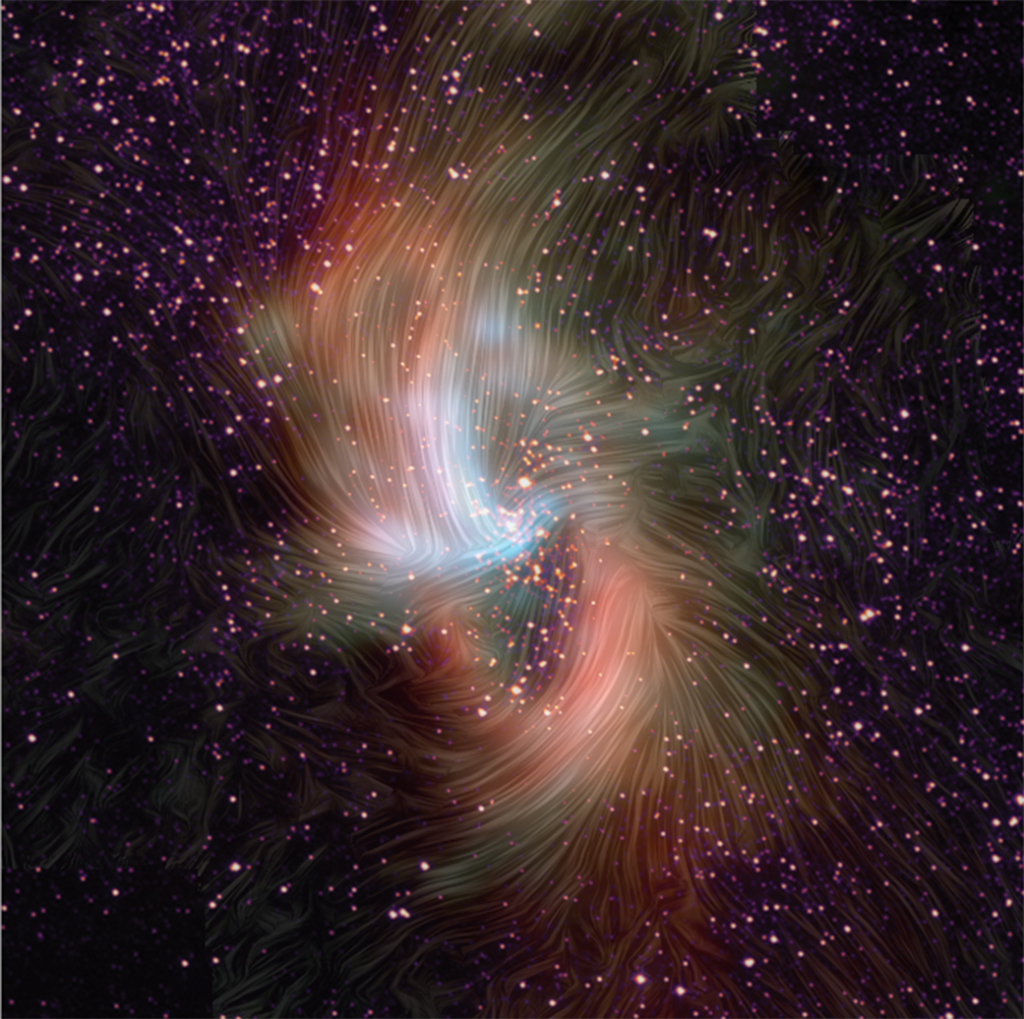
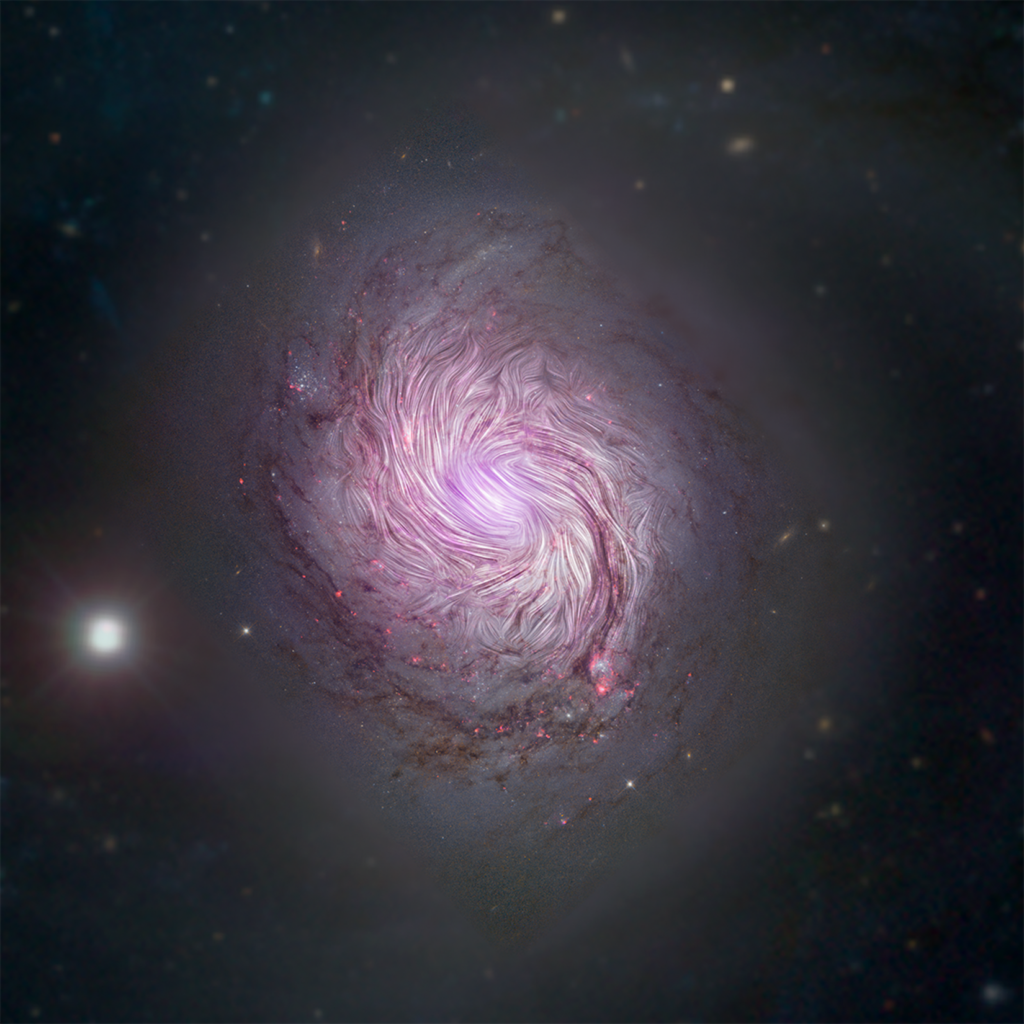
(Top) In the Galactic center, the mini-spiral of inflowing gas appears to be guided by the magnetic fields that have been established there. (Bottom) On much larger scales, the entire star-forming disk of the spiral galaxy M77 appears to be in the thrall of its magnetic dynamo. (Credit: NASA/SOFIA).
Clues to Exoplanetary Weather – Cloudy with a Chance of Rocks:
Thanks to the Kepler Space Telescope and the follow-on Transiting Exoplanetary Survey Satellite (TESS), astronomers – and citizen scientists – have detected more than 4,000 extra-solar planets. The detections were made from the slight diminution in light that was observed, whenever a planet transited in front of (or behind) its host star. Some of these planets have been found to sport atmospheres that slightly alter the stellar spectra during their transits. By subtracting out the spectra of the stars themselves, astronomers have been able to derive spectra of the planetary atmospheres. To their surprise – and dismay – many of the spectra turned out to be mostly featureless. Working with what they could see, astronomers have found some evidence for atmospheric hydrogen, sodium, carbon monoxide, carbon dioxide, methane, ammonia, and water vapor. Most of these detections were from the atmospheres of gas giant planets.
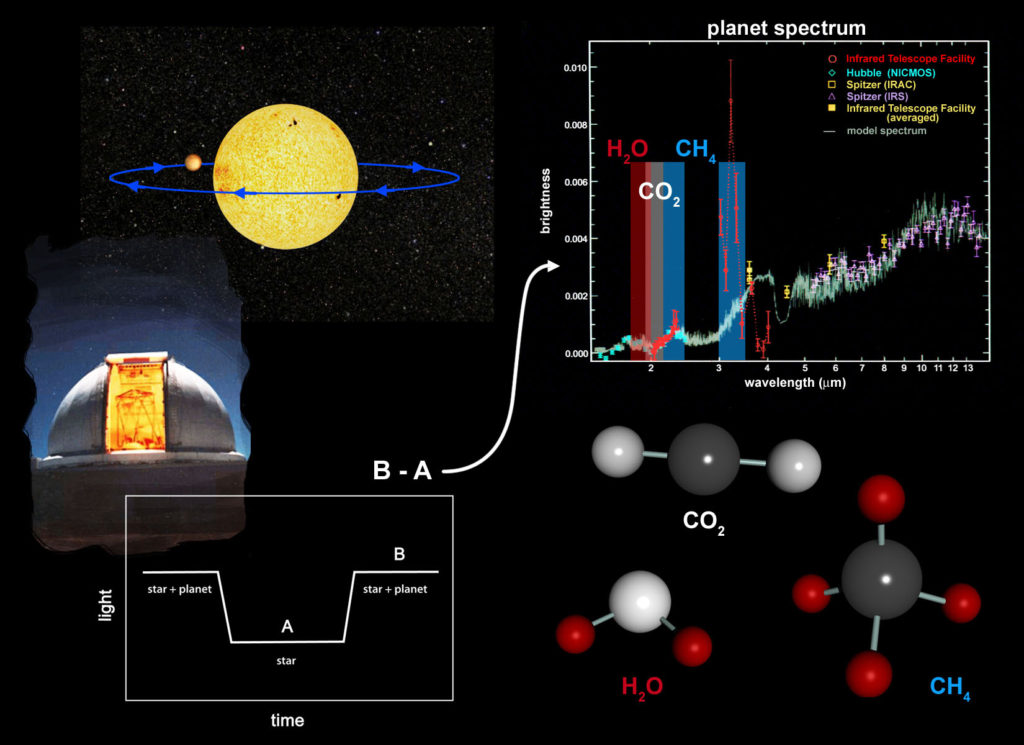
An exoplanet transiting in front of (or behind) its host star will dim the received light by a small percentage that varies with wavelength due to the planet’s absorbing and emitting atmosphere. Once the spectrum of the star itself is subtracted, the resulting spectrum of the planet’s atmosphere will contain features associated with the molecules in that atmosphere. This forensic work has turned out to be extremely challenging due to the vexing effects of haze and clouds in the planetary atmospheres. (Credit: NASA/JPL-Caltech)
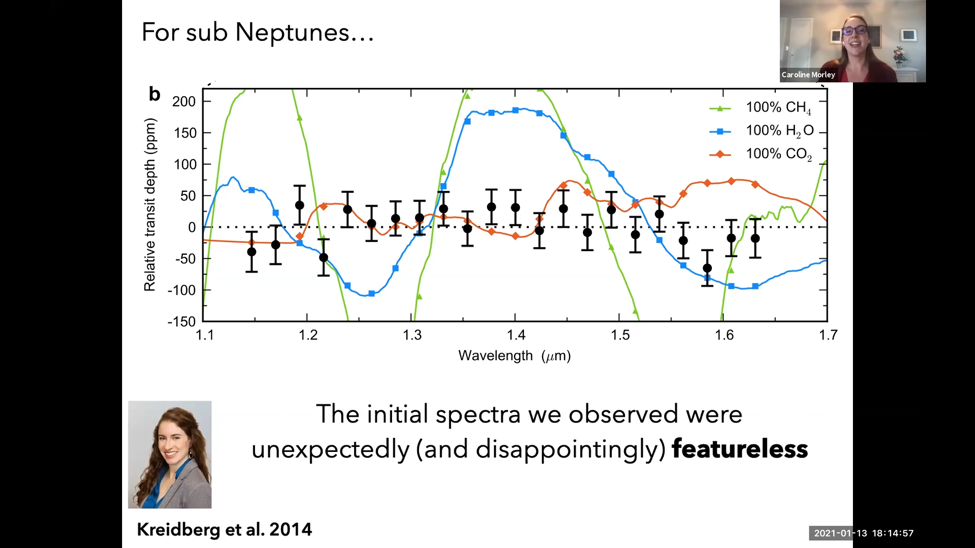
A screenshot from Caroline Morley’s keynote talk, where she cited the “flat” spectrum that was observed by Laura Kreidberg and colleagues in the atmosphere of a sub-Neptune exoplanet. Such a featureless spectrum strongly contradicted the model predictions, and so has required an alternative explanation which Morley described.
In her Annie Jump Cannon Award keynote talk, Caroline Morley (University of Texas) focused on the spectra of “sub-Neptune” planets in close orbits around their host stars – and their comparison with spectra of the coolest brown dwarf stars. Her analysis of the transit spectra suggested the presence of a silicate “haze” that is subduing the molecular features and altering the infrared colors that have been observed. Such a rocky haze could only exist if the planet’s atmosphere was insanely hot. Imagine being on a planet that is so close to its star (or very young) that the atmosphere would contain vaporized rock! An equilibrium of sorts would likely play out, such that some of this vapor would occasionally condense back into rocks that could then rain down on your planet. Yikes!! Here, the challenge of assaying the chemical compositions of planetary atmospheres from the available spectra teeters on the hairy edge of feasibility. Prospects should soon get a major boost, when the James Webb Space Telescope (JWST) finally gets launched sometime in late 2021. This large near-infrared telescope in the vacuum of space will be well-suited to capturing the spectra of planetary atmospheres in much greater detail than ever before. Perhaps some biosignatures will be in the offing, so best to stay tuned!
Whither Phosphine on Venus?
Glaring in its absence at the meeting was any mention of phosphine (PH3) in the atmosphere of Venus. Claims of this detection had been made in September 2020 to great fanfare. The molecule is renowned on Earth for its hideous odor and invariable relation to rotting organic matter. Could it be a proxy for life floating somewhere among the Venusian clouds? The prospect of phosphine in the atmosphere of Venus had challenged astrochemists to come up with a way to generate it abiotically without the phosphorus first being oxidized into more stable phosphates (PO4). Consequently, the possible phosphine detection seemed to point toward a biotic origin. The molecular identification was based on a single spectral line that was isolated by astronomers working at both the James Clerk Maxwell Telescope (JCMT) and Atacama Large Millimetre/sub-millimetre Array (ALMA). This single spectral line, in itself, was troubling. Usually, one requires a set of spectral lines to pin down a particular molecular species. But the news was exciting and, unsurprisingly, spread like wildfire. Alas, the original investigators – and other astronomers – have since cast doubt on the methods of isolating the spectral line amidst the inevitable spectral noise that was present. So, we remain in a wait-and-see limbo. Perhaps by the next meeting of the AAS’s Division for Planetary Science in October, we will know.
Summaries of lots more keynote and contributed presentations from the AAS winter meeting can be found on the AAS’s NOVA website at https://aasnova.org/tag/aas-meeting/.
Bill Waller is a former NASA astrophysicist who has carried out a wide variety of astronomical research, education and public outreach programs. He is the author of The Milky Way – An Insider’s Guide, available from Princeton University Press. He currently serves as a U.S. National Astronomy Education Coordinator (NAEC) for the International Astronomical Union’s Office of Astronomy for Education (IAU/OAE).
